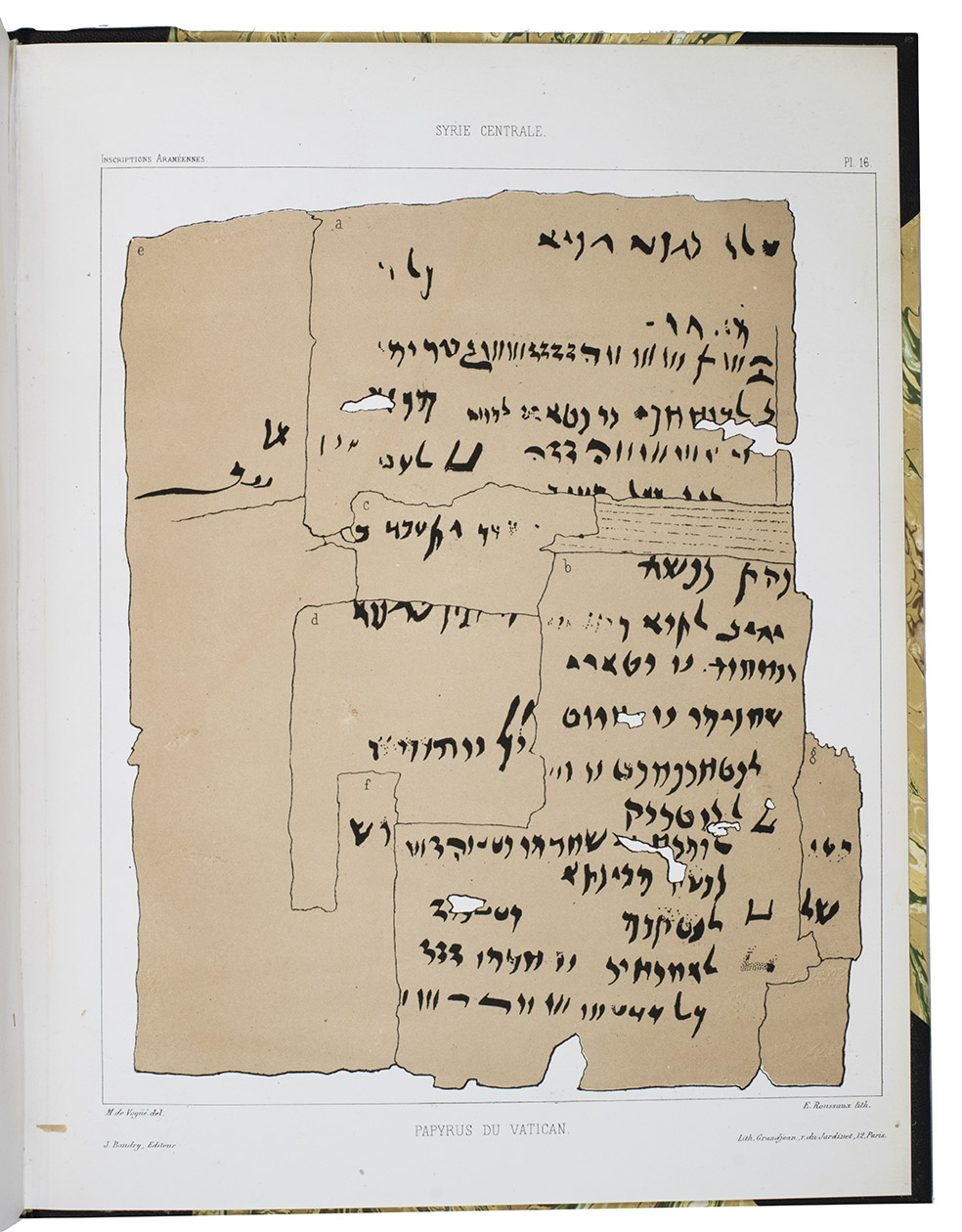
Author: VOGÜÉ, Melchior de.
Title: Syrie centrale. Inscriptions sémitiques publiées avec traduction et commentaire.Paris, J. Baudry, 1868. Folio With 16 plates reproducing inscriptions, plates 1-4, 6, 7, 12, 14 and 15 are engravings and plates 5, 8-11, 13 and 16 are lithographs. All are after drawings by Melchior de Vogüé and all except no. 12 were engraved or lithographed by E. Roussaux and printed by J. Grandjean in Paris. Plate no. 12 was engraved by L. Dardel and printed by Lamoureux in Paris. With additional illustrations in the text and parts of the text in Hebrew, Arabic, and Greek type. Modern half calf, marbled boards, silver lettering on spine.
Description: [4], II, [2], 132 pp.Numerous inscriptions, mostly in Aramaic, can or could be found at the historical and archaeological sites in Syria and further south in the Middle East; for example, in places such as Palmyra and the Hauran region in Syria and the historical Nabatean Kingdom, which stretched from Damascus to the Red Sea with Petra as its capital. Count Melchior de Vogüé collected, translated and analysed these inscriptions during his travels in 1861-62 through Syria and Palestine. He combined his own findings with those of "M[onsieur]. Waddington" into the present work. Waddington was probably the French statesman and diplomat William Henry Waddington (1826-1894), who did some archaeological research in Asia Minor, Greece and Syria. The inscriptions, together with translations and commentaries, are valuable for linguistic research on Aramaic. The fact that some of these inscriptions come from the - now mostly destroyed - ruins in Palmyra only add to the value and importance of the work. In 1877 Vogüé published a second part of the Inscriptions sémitiques, including "inscriptions sabéennes", found in the region south east of Damascus in Syria.Charles-Jean-Melchior de Vogüé (1829-1916) was a French archaeologist, diplomat and author of numerous works on the history of and archaeological findings in the Middle East. As a diplomat, he worked at the French Embassy in Saint Petersburg in 1849 and was appointed French ambassador to Constantinople in 1871 and Vienna in 1875.Some annotations in pencil in the margins, slight browning throughout, minor tears in the margins of a few pages, most repaired with tape. Modern binding and endpapers by bookbindery Erends in Groningen, the Netherlands, with one of their small labels on the front paste-down. Overall in very good condition.l Gran-Aymerich, "Vogüe, Charles Jean Melchior", in: Pouillon (ed.), Dictionnaire des orientalistes de langue française, pp. 1025-1026.
Keywords: [9EE06DC76F16] ASIA|[9EE06DC76F16] ASIA -> [H9DK9EDSCHIJ] Central & West Asia|[94684889A2BD] BOOK HISTORY, EDUCATION, LEARNING & PRINTING|[94684889A2BD] BOOK HISTORY, EDUCATION, LEARNING & PRINTING -> [J5ICED84YBRC] Greek & Non-Western Types|[G8L0P27N9XV3
Title: Syrie centrale. Inscriptions sémitiques publiées avec traduction et commentaire.Paris, J. Baudry, 1868. Folio With 16 plates reproducing inscriptions, plates 1-4, 6, 7, 12, 14 and 15 are engravings and plates 5, 8-11, 13 and 16 are lithographs. All are after drawings by Melchior de Vogüé and all except no. 12 were engraved or lithographed by E. Roussaux and printed by J. Grandjean in Paris. Plate no. 12 was engraved by L. Dardel and printed by Lamoureux in Paris. With additional illustrations in the text and parts of the text in Hebrew, Arabic, and Greek type. Modern half calf, marbled boards, silver lettering on spine.
Description: [4], II, [2], 132 pp.Numerous inscriptions, mostly in Aramaic, can or could be found at the historical and archaeological sites in Syria and further south in the Middle East; for example, in places such as Palmyra and the Hauran region in Syria and the historical Nabatean Kingdom, which stretched from Damascus to the Red Sea with Petra as its capital. Count Melchior de Vogüé collected, translated and analysed these inscriptions during his travels in 1861-62 through Syria and Palestine. He combined his own findings with those of "M[onsieur]. Waddington" into the present work. Waddington was probably the French statesman and diplomat William Henry Waddington (1826-1894), who did some archaeological research in Asia Minor, Greece and Syria. The inscriptions, together with translations and commentaries, are valuable for linguistic research on Aramaic. The fact that some of these inscriptions come from the - now mostly destroyed - ruins in Palmyra only add to the value and importance of the work. In 1877 Vogüé published a second part of the Inscriptions sémitiques, including "inscriptions sabéennes", found in the region south east of Damascus in Syria.Charles-Jean-Melchior de Vogüé (1829-1916) was a French archaeologist, diplomat and author of numerous works on the history of and archaeological findings in the Middle East. As a diplomat, he worked at the French Embassy in Saint Petersburg in 1849 and was appointed French ambassador to Constantinople in 1871 and Vienna in 1875.Some annotations in pencil in the margins, slight browning throughout, minor tears in the margins of a few pages, most repaired with tape. Modern binding and endpapers by bookbindery Erends in Groningen, the Netherlands, with one of their small labels on the front paste-down. Overall in very good condition.l Gran-Aymerich, "Vogüe, Charles Jean Melchior", in: Pouillon (ed.), Dictionnaire des orientalistes de langue française, pp. 1025-1026.
Keywords: [9EE06DC76F16] ASIA|[9EE06DC76F16] ASIA -> [H9DK9EDSCHIJ] Central & West Asia|[94684889A2BD] BOOK HISTORY, EDUCATION, LEARNING & PRINTING|[94684889A2BD] BOOK HISTORY, EDUCATION, LEARNING & PRINTING -> [J5ICED84YBRC] Greek & Non-Western Types|[G8L0P27N9XV3
Price: EUR 5000.00 = appr. US$ 5434.23 Seller: A. Asher & Co. B.V.
- Book number: ABC_46529
- Book number: ABC_46529